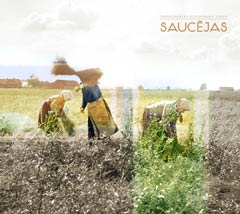
I used to associate Saucējas almost exclusively with the traditional songs of the northeastern corner of Latvia, in particular Liepna. Then all of a sudden they made a 180-degree turn and started singing songs from, of all places, southwestern Kurzeme—about as far from Liepna as you can get without leaving the borders of Latvia. But Saucējas have found a way to successfully connect the two regions through the hearty, forceful and full singing styles still alive in both places. The group’s first and self-titled compact disc contains songs from both regions, as well as Sēlija, which is another favorite region of Saucējas.
Compared with the rich and full Latgale harmonies and the Selonian love of dissonance, the Kurzeme melodies sound more straightforward and melodic to the Western ear. They often encompass wider ranges and make use of “tra-la-la” refrains. The songs on the CD are loosely grouped according to geography, but more so by topic. Saucējas has thereby achieved the maximum effect possible from a vocals-only group that sings almost everything at more or less the same volume setting. (According to the liner notes, the Latgalians themselves described certain work songs as ‘yelling songs.’) In other words, the average ear can only stand so much top-of-the-lungs singing or dissonance at a time, and Saucējas has done as good a job as possible in dispersing it.
Authenticity is the goal of Rīga-based Saucējas. The group, seven young women led by folklorist Iveta Tāle, is dedicated to the traditional singing styles of Latvia and take its stuff seriously. The women learn songs directly from field recordings or teicējas (traditional singers who have inherited a large repertoire of local songs). It is said that some singers imitate teicējas to a fault, in effect sounding like old women themselves. But the women of Saucējas make the songs their own. They are women “in their strongest years,” as is said in Latvian, and will not be confused with old women.
The Saucējas disc begins with “Siestīs, bōlen, augstā zyrgā,” one of the group’s signature songs, and other talka work songs from the northeastern part of Latvia. “Tolka lila, tolka moza” features typical harmonies and fine slides and glides in the melody line. The drone in “Pōri, pōri leita tyuce” is the most simple form of harmony there is, but the result, which includes a strong overtone, is a surprisingly full sound. Four saucējas (lead singers) take turns singing four variations of the melody, some featuring half and quarter tones. It’s a treat for lovers of authentic singing traditions, especially if you can understand the words, but will unfortunately become tedious for many listeners.
Next up are outdoor spring and summer songs, starting off with “Iz tū pusi bolsu laidu.” A shepherd’s song from Selonia follows, and soon after is “Gavilēti gavilēja,” another song with calls after and within each verse. Such songs, though strange-sounding at first, are interesting in that they are rarely heard or recorded. Connoisseurs of dissonance will enjoy “Nekūko, dzeguzīte” and “Aiz Daugavas melni meži,” the latter of which includes an overtone-inspired harmony. Remember that much of the music on this CD was originally meant to be sung outdoors.
“Kū tei muna Laime dora,” a short song from northeastern Latgale, introduces the wedding theme. In “Škiretīsi zūšu pulki” you can practically hear the singers bouncing along with the rhythm, as is typical in certain traditions. Also interesting are the text-based variations—the lilts, quivers, slides and epentheses—of the lead singer. Next is the rich harmony and wonderful high chest-voice notes of “Kupla līpeņa izauga.” After that Saucējas head to Kurzeme with the scolding (apdziedāšanās) song “Linu, linu, ne pakulu” from Rucava. Even though the text is different, the song is a variation of the “Es nenācu šai vietā” melody and is probably the only commonly recognizable melody on the CD. “Ciema meitas žēli rauda” is a short and angry song, also from Kurzeme.
The two next-to-last songs jump back to the spring theme: “Skan balsīnis rītā agri” and “Nākat, puiši, nelepojat,” which also contains some nice overtones and an interesting switch from a minor to a major key. The CD ends with “Tad jāsim mēs uz ķezbierēm,” a catchy monophonic popular song (ziņģe) about young men visiting neighbor girls.
The liner notes do not contain song texts, but do provide valuable information in Latvian and English regarding the singing traditions. Also listed are the source materials for each song.
The Saucējas CD is pure traditional vocal music with not a present-day touch to it, other than that it was recorded in a studio in 2007 by women who fit in on the streets of a thriving contemporary city. Listeners who appreciate strong voices and devotion to traditional singing styles will consider this CD a valuable addition to their music libraries.
Details
Saucējas
Saucējas
Lauska, 2007
CD15
© 1995-2024 Latvians Online
Please contact us for editorial queries, or for permission to republish material. Disclaimer: The content of Web sites to which Latvians Online provides links does not necessarily reflect the opinion of Latvians Online, its staff or its sponsors.




